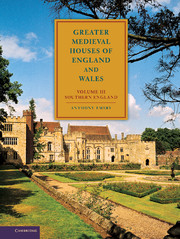Book contents
- Frontmatter
- Contents
- Acknowledgements
- List of abbreviations
- Introduction
- PART I THE THAMES VALLEY
- PART II LONDON AND SOUTH-EAST ENGLAND
- 6 London: an introduction
- 7 London: bibliography
- 8 London: survey
- 9 South-east England: historical background
- 10 South-east England: architectural introduction
- 11 The impact of the Hundred Years' War on English domestic architecture
- 12 South-east England: bibliography
- 13 South-east England: survey
- Appendix 3 London and south-east England castles: residential additions
- Appendix 4 London and and south-east England: residential licences to crenellate
- PART III SOUTH-WEST ENGLAND
- Appendix 5 Castles of south-west England: residential additions
- Appendix 6 South-west England: residential licences to crenellate
- Appendix 7 The architectural value of John Leland and the Buck brothers
- List of plates
- List of figures
- Index
- Index of houses in volumes I, II and III
11 - The impact of the Hundred Years' War on English domestic architecture
from PART II - LONDON AND SOUTH-EAST ENGLAND
Published online by Cambridge University Press: 05 June 2012
- Frontmatter
- Contents
- Acknowledgements
- List of abbreviations
- Introduction
- PART I THE THAMES VALLEY
- PART II LONDON AND SOUTH-EAST ENGLAND
- 6 London: an introduction
- 7 London: bibliography
- 8 London: survey
- 9 South-east England: historical background
- 10 South-east England: architectural introduction
- 11 The impact of the Hundred Years' War on English domestic architecture
- 12 South-east England: bibliography
- 13 South-east England: survey
- Appendix 3 London and south-east England castles: residential additions
- Appendix 4 London and and south-east England: residential licences to crenellate
- PART III SOUTH-WEST ENGLAND
- Appendix 5 Castles of south-west England: residential additions
- Appendix 6 South-west England: residential licences to crenellate
- Appendix 7 The architectural value of John Leland and the Buck brothers
- List of plates
- List of figures
- Index
- Index of houses in volumes I, II and III
Summary
INTRODUCTION
THE phrase ‘The Hundred Years’ War', first used by Desmichels in 1823, may be a highly convenient term to describe the attenuated late medieval conflict between England and France, but it is conceptually misleading. It is not so much that this struggle for supremacy extended well beyond the traditional limits of 1337 to 1453, but the fact that it was not a continuous war but a series of vicious conflicts, separated by extended periods of uneasy peace or truce marred by sporadic hostilities. Nor was it simply between the Plantagenet and Valois dynasties, but also between them and fiefs such as Brittany, Flanders, and Burgundy who chose to support one side and then the other as the political or economic situation demanded. To a lesser extent, it also involved Scotland, the Holy Roman Empire, Castile, Navarre, and Portugal, creating a complex pattern of political, financial, economic, military, and social consequences. Though this essay is precise in its scope, one consequence common to this as to most other aspects of the War is that a conflict which began between protagonists who only knew the feudal order was concluded about 150 years later by an increasingly meritorious society at the dawn of the Renaissance.
The origins of the conflict were deep rooted and lay at least as far back as the Angevin inheritance of Aquitaine in the mid-twelfth century. The more immediate cause was the dynastic crisis in France in the years following the death of Philip IV in 1314 and his short-lived successors, and the feudal responsibilities and family conflict inherent in the close relationship between the royal houses of France and England.
- Type
- Chapter
- Information
- Greater Medieval Houses of England and Wales, 1300–1500 , pp. 274 - 293Publisher: Cambridge University PressPrint publication year: 2006



